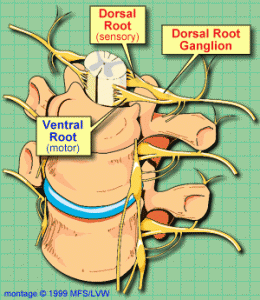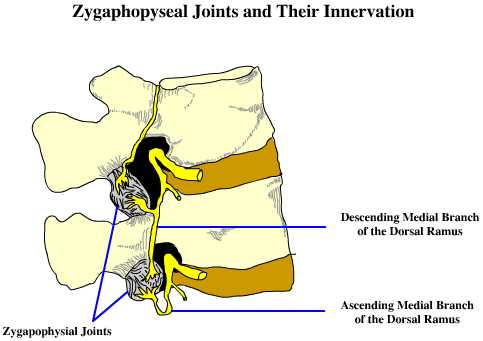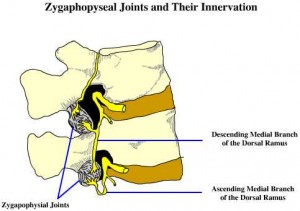By Chris Faubel, MD —
The importance of recognizing the lumbar facet joints as a common source of low back pain can not be emphasized enough.

Knowing the innervation of the lumbar facet joints is critical for performing two very common and related interventional pain procedures.
- Medial Branch Blocks
- Radiofrequency Ablation/Neurotomy (of the medial branches) – RFA
Being able to correctly and effectively perform these two procedures requires an excellent understanding of the course of the medial branch of the
dorsal primary ramus, along with the knowledge that each facet joint has dual innervation.
- I will discuss the course of the medial branch and the actual procedures themselves in separate posts.
As you can see from the image (above/right), the dorsal root and ventral root at a particular spinal level combines to form a mixed spinal nerve. The mixed nerve (sensory and motor fibers) quickly splits into a ventral and dorsal primary ramus. For the lumbar spine, that ventral root goes down the lower extremity to provide sensation and motor control.
The dorsal primary ramus loops posteriorly and splits into a lateral branch, intermediate branch, and a medial branch. It is this medial branch of the dorsal primary ramus that supplies the sensation for the facet joints (zygapophyseal joints).
Dual Innervation
- This concept of dual innervation is very important to remember.
- The exiting mixed spinal nerve gives off the eventual medial branch that supplies the facet joint at that level, and the joint immediately below.
- Therefore, each zygapophyseal joint receives innervation from the medial branch at that level, and from the the medial branch above it.
- Photo (right): Note the facet joints (with capsule) have nerves (yellow) from the same level, and from the level above.
- Example: The L4/L5 foramen has the L4 mixed nerve exiting. The L4 dorsal ramus gives rise to the medial branch, which then innervates the L4/L5 facet joint (same level), and thebelow L5/S1 facet. That same L5/S1 facet also receives innervation from the L5 dorsal ramus.
Note: The L5 dorsal ramus does NOT have a medial branch, so you block or “burn” the dorsal ramus itself.
Clinical Relevance
- Because each facet joint receives dual innervation from two different medial branches, in order to eliminate all sensory supply to a particular facet joint, you need to perform radiofrequency ablation (neurotomy) on two separate medial branches.
- Example: In order to denervate the L5/S1 facet from the example above, you would need to do RFA on the L4 and L5 medial branches.
Typical Medial Branch Block (MBB) and Radiofrequency Ablation (RFA) Levels
- In order to denervate the L4/L5 and L5/S1 facets on one side (the two lowest levels), we’ll block or “burn” the L3 and L4 medial branches, and the L5 dorsal primary ramus. [3 levels]
Summary
- Medial branch innervates –> Same level and one below


















Excellent topics. After long searching I found this online that, Extreme Health Chiropractic
Thank you! This is a sweet page for med students!
Oopsie. You forgot the branches from the ventral ramus, plus branches that come off prior to the bifurcation of ventral/dorsal rami. Might want to read more than the pamphlets you get from the Stryker reps: Anat Clin (1983) 5 : 17-28
This explains the not-infrequent failure to block facet pain. RF may not be the way to go. Set the wayback machine to 1976 and you’ll find Shealy, one of the early proponents of facet denervation, preferred phenol. Sadly, phenol is generic and doesn’t make any money for device manufacturers.
Al, I’m confused by your reply here. My purpose is to explain the relevant anatomy as it pertains to lumbar facet joint radiofrequency ablation. If you want to use phenol or dehydrated alcohol, go right ahead. I’m not risking the neuroma potential and especially the potential to kill the nerve roots in the area.
how do you bill for block the L5/s1 facet joint? by block the L4 medial branch and L5 dorsal ramus? I had an insurance peer reviewer call me after I had performed an L3 and l4 medial branch block and an L5 dorsal ramus( I thought it does give off a medial branch near the facet), and she stated its not correct to bill for this
The L5/S1 facet joint is innervated by the L4 medial branch and the L5 dorsal primary ramus. The L3 shouldn’t be typically involved at all.
What are you calling the nerve that runs caudally through the groove between the transverse and superior articular processes at L5? The confusion arises because although this branch comes from L4, it is blocked/burned at the L5 junction.
That’s the L4 medial branch nerve. The L5 runs near the S1 superior articular process and sacral ala.